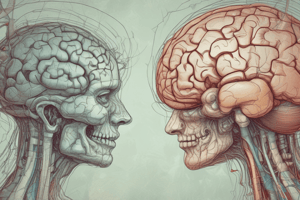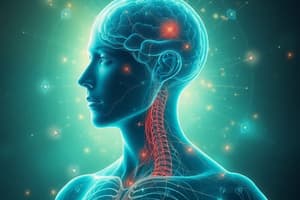Podcast
Questions and Answers
Which cortical areas do Brodmann areas 4 and 6 correspond to?
Which cortical areas do Brodmann areas 4 and 6 correspond to?
- Cortical areas of somatosensory sensitivity
- Broca's and Wernicke's areas
- Cortical areas of voluntary movement (correct)
- Prefrontal areas
What is a primary function of the corpus striatum related to motor control?
What is a primary function of the corpus striatum related to motor control?
- Control of ciliary body striae
- Organization of involuntary motor behavior aspects
- Determination of error in voluntary movements (correct)
- Voluntary control of striated muscle
The translation of emotional reactions into changes in states of wakefulness and attention involves connections between which structures?
The translation of emotional reactions into changes in states of wakefulness and attention involves connections between which structures?
- The reticular substance and the cerebellum
- The reticular substance and the striatum
- The limbic system and the cerebral cortex
- The limbic system and the reticular substance (correct)
Commissural fibers in the subcortical white matter primarily establish connections between which structures?
Commissural fibers in the subcortical white matter primarily establish connections between which structures?
Where is the reticular formation primarily located?
Where is the reticular formation primarily located?
What is a key role of the hypothalamus?
What is a key role of the hypothalamus?
Which motor-function related nuclei can be found in the brainstem?
Which motor-function related nuclei can be found in the brainstem?
The intentionality of our behavior is highly dependent on the intervention of which brain areas?
The intentionality of our behavior is highly dependent on the intervention of which brain areas?
Which of the following is a fundamental function of the cerebellum?
Which of the following is a fundamental function of the cerebellum?
What is the term for the junction between a muscle and a tendon?
What is the term for the junction between a muscle and a tendon?
Which structures are contained within muscle fibers?
Which structures are contained within muscle fibers?
Energy for ATP resynthesis in mitochondria is obtained through which processes?
Energy for ATP resynthesis in mitochondria is obtained through which processes?
Cross-bridge formation in muscle contraction occurs when calcium concentration increases in which location?
Cross-bridge formation in muscle contraction occurs when calcium concentration increases in which location?
What is the correct sequence of events at the beginning of force production in muscle contraction?
What is the correct sequence of events at the beginning of force production in muscle contraction?
Which three proteins constitute the thin filaments within a sarcomere?
Which three proteins constitute the thin filaments within a sarcomere?
Flashcards
Brodmann areas 4 and 6
Brodmann areas 4 and 6
Cortical areas responsible for voluntary movement.
Striatum
Striatum
Involved in controlling voluntary muscle movement.
Emotional reaction translation
Emotional reaction translation
Connects limbic system with reticular formation for emotional responses.
Commissural fibers in subcortical white matter
Commissural fibers in subcortical white matter
Signup and view all the flashcards
Reticular formation location
Reticular formation location
Signup and view all the flashcards
Hypothalamus Function
Hypothalamus Function
Signup and view all the flashcards
Motor nuclei in the brainstem
Motor nuclei in the brainstem
Signup and view all the flashcards
Intentionality of behavior
Intentionality of behavior
Signup and view all the flashcards
Cerebellum primary function
Cerebellum primary function
Signup and view all the flashcards
Muscle-Tendon Transition
Muscle-Tendon Transition
Signup and view all the flashcards
Muscle fibers contain:
Muscle fibers contain:
Signup and view all the flashcards
ATP resynthesis in mitochondria
ATP resynthesis in mitochondria
Signup and view all the flashcards
Cross-bridge formation
Cross-bridge formation
Signup and view all the flashcards
Thin filaments components
Thin filaments components
Signup and view all the flashcards
Anaerobic alactic process is based on
Anaerobic alactic process is based on
Signup and view all the flashcards
Study Notes
- Areas 4 and 6 of Brodmann correspond to cortical areas of voluntary motor control.
- The striatum has a fundamental role in the organization of involuntary aspects of motor behavior.
- Emotional reactions translated into changes in waking state and attention involves the limbic system connected to the reticular substance.
- Commissural fibers in the subcortical white matter connect the right and left sides of the cerebral cortex.
- The reticular substance is mainly located in the brainstem.
- The hypothalamus is an important center for controlling the autonomic nervous system.
- Various nuclei related to motor functions are found in the brainstem, including the red nucleus and vestibular nuclei.
- Intentionality of behavior depends on the intervention of the area of voluntary motor control of the cerebral cortex in association with the cerebellum.
- The cerebellum is fundamental in the control of the timing and precision of movements.
- The transcription between the muscle and the tendon is called the myotendinous junction.
- Muscle fibers contain myofibrils and sarcomeres.
- Energy to resynthesize ATP in mitochondria comes from oxidative processes, resulting in CO2 and water.
- The formation of cross-bridges occurs when calcium concentration increases in the sarcoplasmic reticulum.
- Events that occur until the start of force production include the propagation of muscle action potential, establishment of cross-bridges, and transmission of force to bone after calcium release.
- In the sarcomere, thin filaments are composed of actin, troponin, and tropomyosin.
- The anaerobic alactic process is based on the hydrolysis of phosphocreatine without oxygen use.
- During concentric dynamic concentration, gliding is verified coming from the Z lines (shortening) of the thin filaments over the thick ones inside the sarcomere.
- The locations on the filaments where myosin heads bind during contraction are called active sites of actin.
- Separating the sarcomeres we find Z disks.
- Interneurons are neurons of the medullary gray matter that are very important in the processing of information.
- The "Medulla 2" figure represents a polysynaptic and homolateral reflex arc.
- The posterior horns of the medullary gray matter have sensory functions and are the entry point for afferent fibers.
- A reflex is a response to a stimulus processed in the medullary gray H.
- A polysynaptic reflex involves a sensory neuron, one or more interneurons, and a motor neuron.
- Cell bodies of alpha and gamma motor neurons are located in the anterior horns of the medullary gray H.
- Functionally, the white matter of nervous tissue conducts information at high speed.
- Compared to the endocrine system, the nervous system acts immediately and briefly through electrochemical impulses.
- Spinal cord corresponds to the lower level of the central nervous system and is responsible for the simplest and fastest neural control.
- The space between a nerve cell and the following cell is the synaptic cleft.
- During the action potential, as sodium ions enter the cell, the intracellular environment becomes more positive.
- In response to a stimulus, if the neuron's membrane potential becomes more negative than the resting potential, the cell is hyperpolarized.
- In postsynaptic inhibition, the chemical mediator (neurotransmitter) induces a state of hyperpolarization in the postsynaptic membrane.
- During sustained discharge in a neuronal circuit, once initiated, it can maintain operation for quite some time without needing external stimuli.
- The cochlea is the auditory organ located in the inner ear.
- The outer layer of the eye is called the sclera.
- The vestibule contains important receptors in the process of static equilibrium and determination of linear acceleration.
- Somatic sensibility carries information origined from muscular, articular and cutaneous receptors.
- The sacred plexus innervates mainly the posterior region of the thigh and leg.
- An example of a mixed (sensory and motor) cranial nerve is the vagus nerve (X pair).
- The function of the terminal buttons is related to the transmission of stimuli to the next neuron [True].
- Convergent circuits, once started, can keep working for a while without external stimuli [True].
- The refractory period is the time interval during which neuron has a lower excitement [False].
- in the sensitve ganglion the afferent cel make synapses with an ascendente neuron [False].
- The striatum plays a central role in the organization of involuntary motor behavior [True].
- The cochlea is located in the external ear and is related to hearing [False].
- All cranial nerves are mixed [False].
- The sarcolemma is the cellular membrane of the muscle fiber [True].
- During concentric dynamic contraction, there is a sliding of the thin filaments inside the sarcomere [True].
- T tubules allow the communication between sarcoplasmic reticulum and sarcolemma [True].
- There are no synapses in the white matter of the CNS [True].
- The function of terminal buttons is related to the reception of stimuli [False].
- Membrane depolarization is produced by excitatory mediators and repolarization by inhibitory mediators [True].
- The first stage of information processing takes place at the sensory receptors [True].
- In the process of focusing images on the fovea, the lens shifts back and forth [False].
- The middle ear is where transduction takes place in the auditory process [False].
- The muscle cell is called a myofibril [False].
- T tubules allow communication between the sarcolemma surface and the sarcoplasmic reticulum [True].
- The sarcoplasm is where calcium is stored at rest [False].
- Proprioceptive receptors provide information about the musculoskeletal system and is related to the Somatic NS.
- Anterior roots of the spinal nerves consist of efferent fibers that conduct motor information.
- The cortical area of somatic sensibility processes information from cutaneous and proprioceptive receptors.
- In the cerebral cortex, there are three types of functional areas: sensory, motor, and association.
- The cerebellum is fundamental in the programming of movement.
- Functionally, the thalamus is an important relay center for information from the cerebral cortex.
- Regarding vision, the diameter of the pupil depends on the contraction of the ciliary muscle.
- The motor plate (or neuromuscular junction) is the place where the impulse of the alpha motoneuron is transmitted to the muscle fiber.
- Phosphocreatine is related to the anaerobic alactic process.
- A neuron undergoes an action potential whenever it receives a stimulus equal to or greater than the excitation threshold.
- What distinguishes an excitatory neuron from an inhibitory neuron is the type of neurotransmitter it produces.
- Membrane hyperpolarization means that resting potential is greater.
- Conduction velocity in a nervous circuit is greater if the circuit has fewer synapses and myelinated axons.
- The anterior horns of the medullary gray matter are motor and are the site of entry of efferent fibers.
- Interneurons are neurons of the medullary gray matter, very important.
- Limbic system is mainly related to the affective connotation of lived experiences.
- Regarding vision, the lens plays an important role in focusing.
- In the sarcomere, the I band contains only thin filaments.
- An example of an effort with a high concentration of lactic acid is: A 400 meters race in athletics.
- Proprioceptive receptors provide information about the state of the musculoskeletal system.
Studying That Suits You
Use AI to generate personalized quizzes and flashcards to suit your learning preferences.




